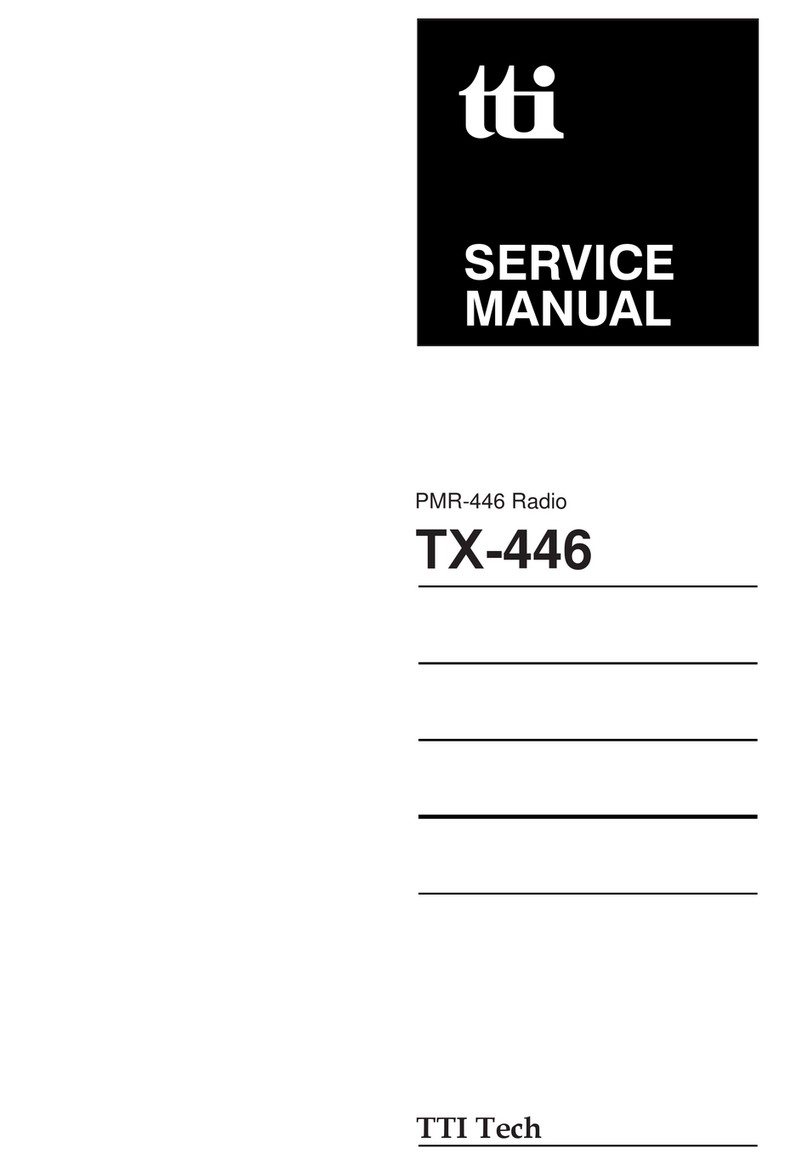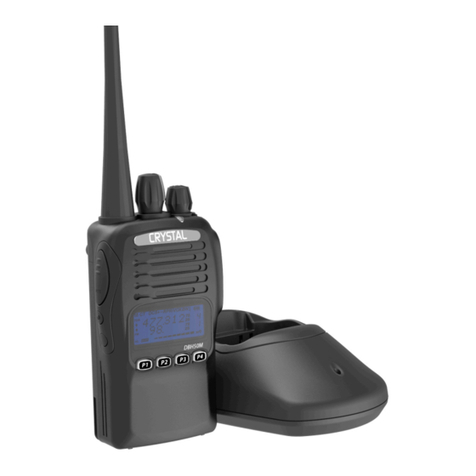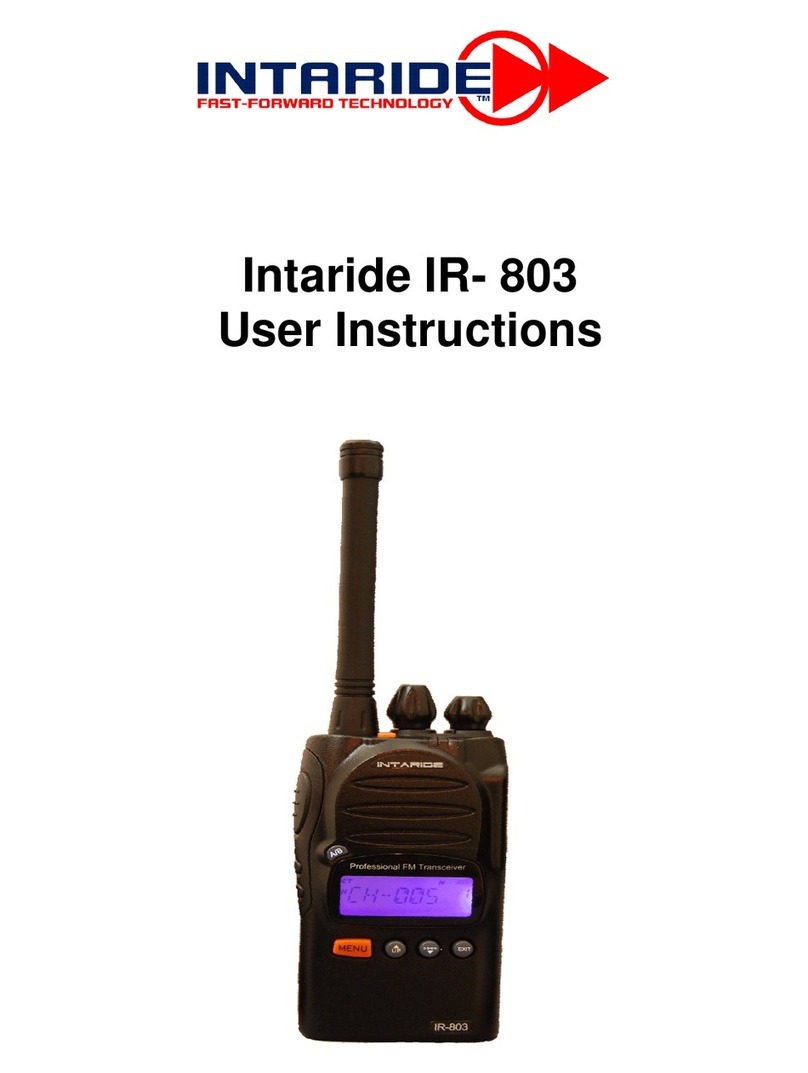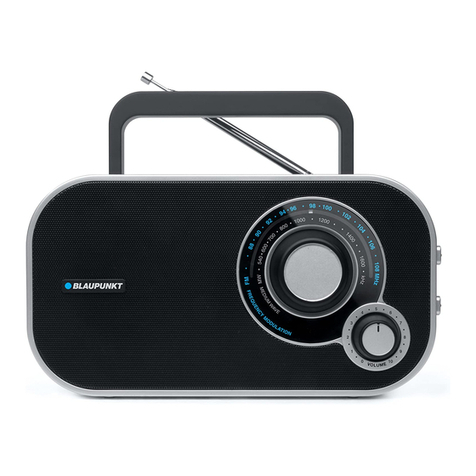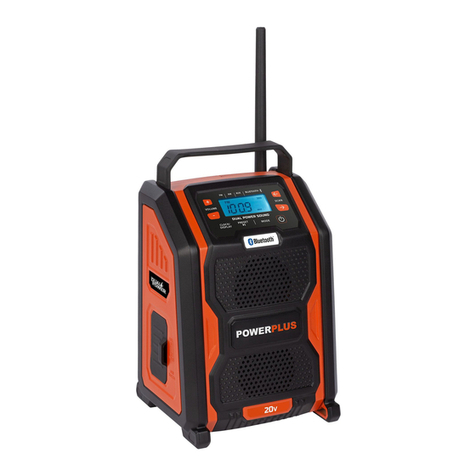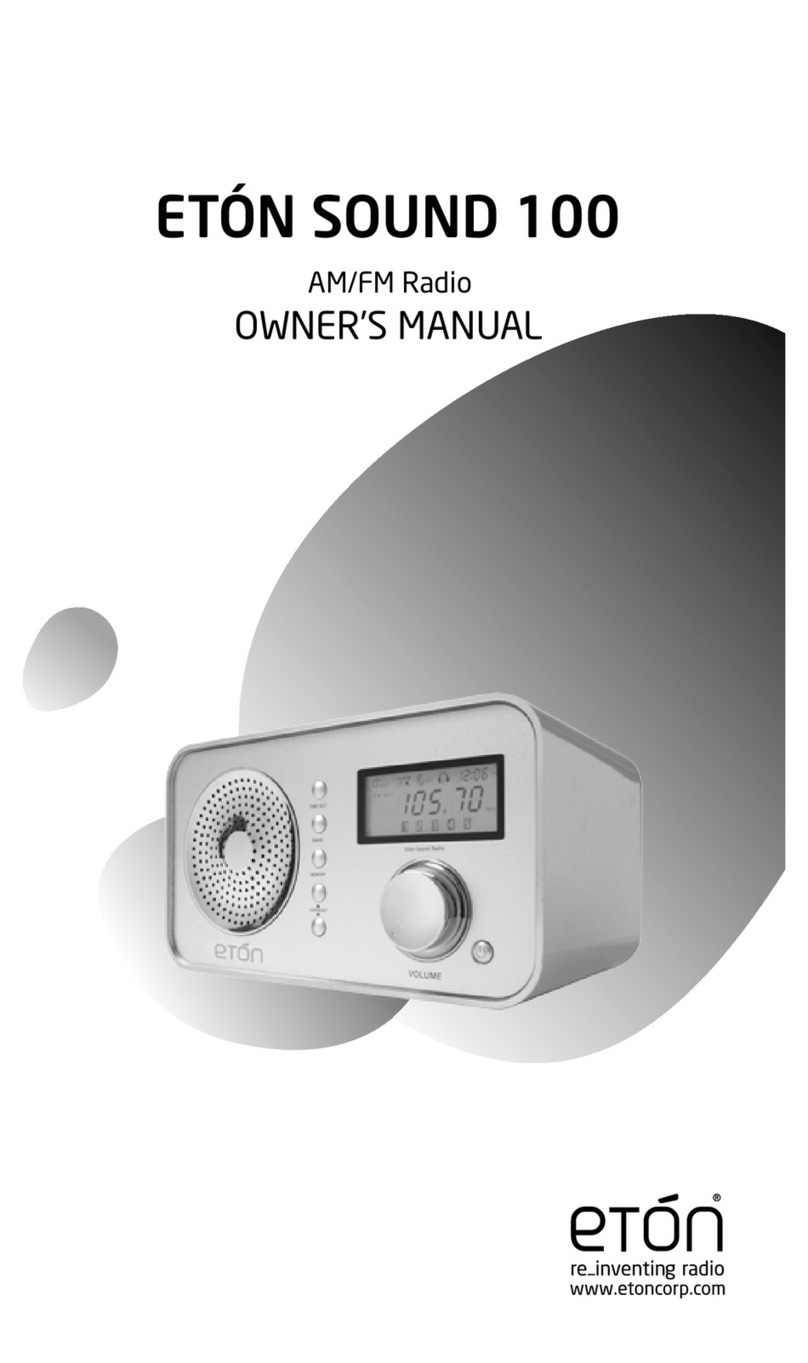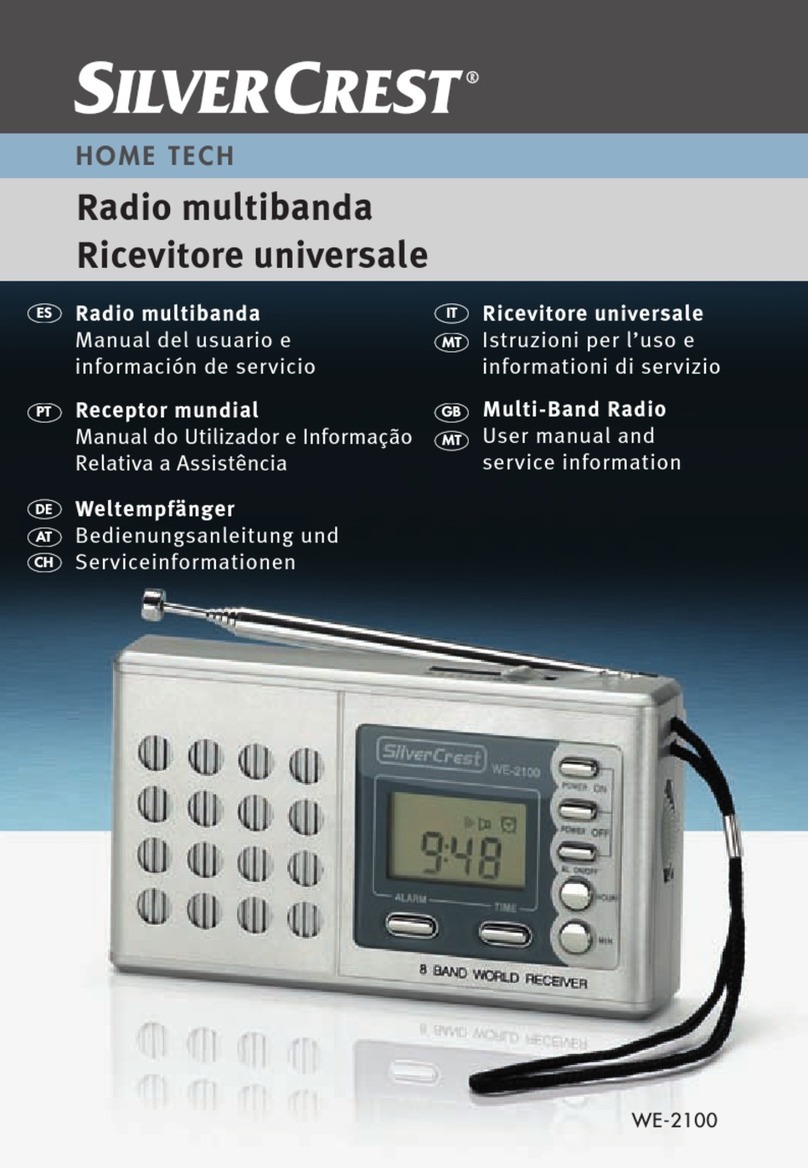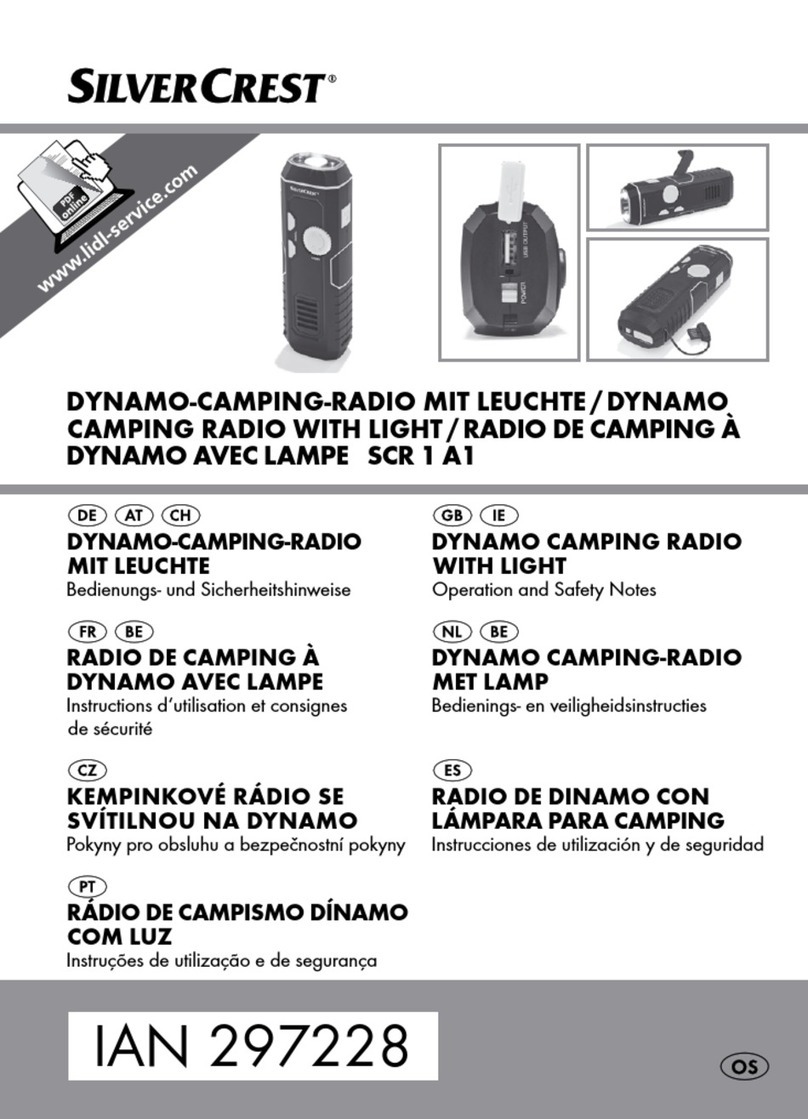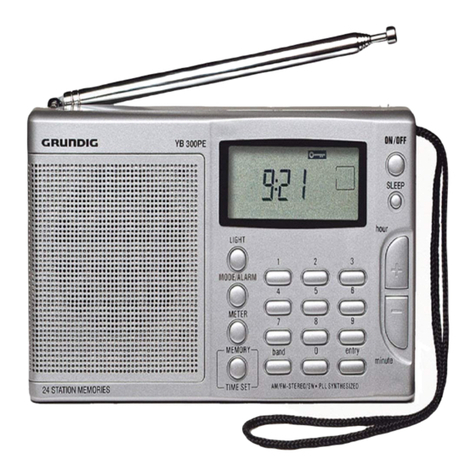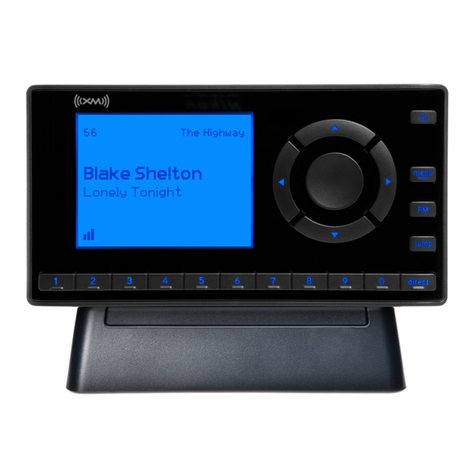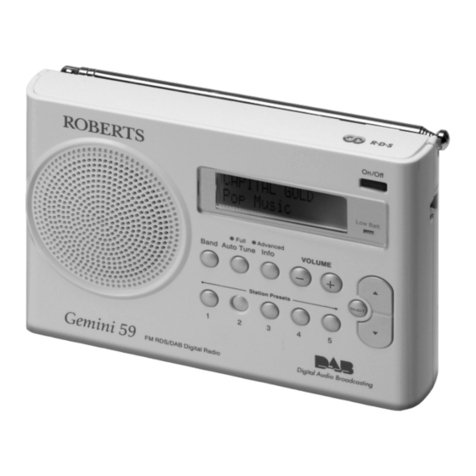tti Tech PMR-122TX User manual

Tech
Private Mobile Radio (PMR) 446MHz
Model : PMR-122TX
Belt Clip
Power on/off,
Scan Button
Push-To
Talk-Button
Down
Button
Mode/Lock
Button
Up Button
Speaker
Microphone
Speaker Microphone/
Charge Jack
Battery Cover
Battery Charging
Contacts
Antenna
LCD
Monitor
Button

2
PMR-122TX Display
Busy Indicator
(Upon receiving a transmission)
Roger Beep Tone Indicator
Monitor Indicator
Transmit Indicator
Low Battery Level Indicator
Channel Number Display
Channel Scan
CTCSS Subcode Indicator
Lock Indicator
Voice Activated
Tansmission indicator
CAUTION
NEVER ATTEMPT TO CHARGE ALKALINE OR DRYCELL
BATTERIES, AS BATTERIES MAY BURST CAUSING
PERSONAL INJURY AND DAMAGE TO
THE PRODUCT.
WHEN RECHARGING NICKEL METAL
HYDRIDE (Ni-MH)
BATTERIES WITH THE SUPPLIED TTI CHARGER AND WALL
ADAPTOR, USE ONLY TTI-APPROVED RECHARGEABLE
BATTERIES. USE OF
THE TTI CHARGER WITH OTHER BRANDS
OF BATTERIES
IS NOT RECOMMENDED, AS BATTERY
CHARGING
TIMES WILL VARY WITH DIFFERENT BRANDS.
AVOID
PLACING THE PMR-122TX RADIO TRANSCEIVER
FOR PROLONGED PERIODS OF TIME IN DIRECT SUNLIGHT
OR TEMPERATURES BELOW -20
º
C OR ABOVE 60
º
C .
KEEP THE ANTENNA AT 1 INCH (2.5cm) AWAY FROM YOUR
HEAD AND BODY. DO NOT USE YOUR PMR-122TX RADIO
TRANSCEIVER WITH A DAMAGED ANTENNA.
PLACE THE RUBBER COVERS ON JACKS WHEN
NOT IN USE.

3
1. PMR-122TX
1) Radio (1)
2) Instruction Manual (1)
Optional Accessories : 1) AC Wall Charger
2) Rechargeable Batteries
Equipment and Accessories Supplied
Powering the transceiver
2. PMR-122TX-2CH (Bonus pack)
1) Radio (2)
2) Instruction Manual (1)
3) Rechargeable Batteries (2 packs)
4) Dual Desk-Top Charger (1)
5) AC Wall Adaptor (1)
6) Ear bud (2)
7) Leather case (2)
CLIP SPRING
RELEASE TAB
BELT CLIP
BATTERY
COVER
Battery installation is made more convenient when the belt clip is
either rotated left or right to the horizontal position, or is removed.
simply rotate the clip in either direction to the horizontal position.
Be careful not to use excessive force. To remove the clip, press
down on the spring release tab and pull the clip straight out from
the radio body.
Installing the batteries
Your PMR-122TX Radio transceiver operates on four AAA
batteries. Alkaline batteries will provide slightly better performance
than rechargeable batteries. When using rechargeable batteries,
battery charging time istypically12-15 hours.
1. Using thumb, press down on battery cover at arrow and slide
cover down.
2. Then lift cover at bottom to open. Remove cover.
3. Insert four AAA batteries (positive (+) end toward the top
begining at left side and alternating positive terminals as shown).
COVER
ARROW
POSITIVE
TERMINALS

4
Charge Information (For PMR-122TX-2CH)
PMR-122TX OPERATIONAL MODES
Power on-off Button
Press and hold the POWER on/off button for at least 2 seconds.
You will hear a confirming melody to indicate the unit is on. To
turn the unit off, press and hold the button for at least 2 seconds.
Monitor/Display Backlight Button
This button is used to to check activity on the current frequency
before transmitting. Check activity by pressing the monitor (M)
Button longer than 1 second ; the icon ( ) will appear on the
display and you will hear static if frequencey is clear. Do not
transmit if you hear conversation. Hold down the Monitor Button
again longer than 1 second, and the icon ( ) will disappear
from the display. This feature is also useful when communicating
with other parties at extreme range. By pressing the monitor
button momentarily, the LCD backlight is turned on ; the LCD
backlight will be turned off automatically in about 5 seconds,
unless the monitor button is pressed momentarily once again.
Control Buttons
CHARGING STAND
POWER JACK
ADAPTOR POWER PLUG
AC WALL ADAPTOR/
CHARGING
TRANSFORMER
* INPUT : 230VAC
* OUTPUT : 8VDC
CHARGING COMPARTMENT
LEDs(2): RED---CHARGING
DESKTOP CHARGING STAND
PMR RADIO CHARGING
COMPARTMENTS(2)
NOTE: Only TTI approved rechargeable batteries can be
recharged in the radio transceiver.

5
Operating Modes and Features
Up Button
In the standby mode, pressing this button will increase the
listening volume. The current volume is indicated (1-7). When in
function edit mode this button will be used to adjust the unit's
settings.
Down Button
In the standby mode, pressing this button will decrease the
listening volume. When in function edit mode this button will be
used to adjust the unit's settings.
Push To talk(PTT)Button
Pressing and holding this button will allow you to speak to any
transceiver that is set to the same channel and privacy code
setting as yours. Hold the transceiver approximately 2 to 3
inches from your mouth as you speak into the built in
microphone. After you have finished speaking, release the PTT
Button to allow reception of incoming signals. Whenever the
button is pressed, the transmit icon ( ) will appear. When
receiving an incoming signal, the busy ( ) icon will appear.
The PTT button can also be used as a two-way call ringer.
Pressing the button twice quickly will call another party on the
same channel.
PMR Operation
- Press and hold the POWER On/Off button for 2 seconds to
turn on power.
- Press the MODE button so the channel number flashes.
- Select the desired channel with the Up and Down Buttons.
The BUSY icon appears to indicate an incoming call.
- Press and hold the PTT button to transmit,then speak into the
microphone clearly and slowly. The transmit icon ( ) appears
on the display while the button is pressed.
- Release PTT button to receive.
- Communication can only be accomplished when the channel
and CTCSS tone frequency of at least two parties are the
same.

6
To enable the VOX operation:
- From standby mode, press the MODE button 3 times unitil the
blinking VOX icon ( ) appears with on or oF.
- Press the Up or Down button to select the VOX on or oF as
desired.
- Press the PTT button momentarily confirm selection.
- When enabled, the VOX icon ( ) appears.
VOX Mode Selection
When your voice or signal is detected using the internal
microphone/headset (purchased separately), the radio transmits
automatically without the need to press the PTT button.
- The CTCSS subcode (01-38) will be displayed on the LCD
panel if the CTCSS tone frequency function is enabled(not oF).
Channel Selection
- From standby mode, press the MODE button once;
the channel number flashes.
- Press the Up or down button briefly to move to the desired
channel number.
- Press the PTT button momentarily to confirm selection.
CTCSS Mode (Sub-Channel) Selection
- From standby mode,press the MODE Button twice; a flashing
oF or sub-channel number is displayed.
- Press the Up or Down button to select the desired sub-channel
for use(01-38)
- Press the PTT button to confirm selection.
- The CTCSS mode can be turned off by selecting oF as the
setting.
NOTE : To communicate with other PMR units, they must be
switched to the same channel and CTCSS subcode. To
communicate with other PMR units that do not have subcodes,
switch your unit to the same channel with the subcode set to oF.
The CTCSS subcodes do not prevent others from hearing your
transmisstion.This will only allow you to ignore all traffic on a
given channel not using the same subcode.
Rogrer Beep Tone
The Roger Beep is a tone which is automatically transmittied
whenever the PTT button is released.

7
Note:
while the SCAN mode is active,the MODE button is inoperative.
In addition, the SCAN mode will reduce the overall battery life
since the battery save function is overridden.
Keypad Lock
The lock function is to avoid the accidental changes of radio
settings. The POWER On/Off, PTT and Volume Up/Down button
will supercede the lock function.
To set the keypad lock operation :
- From standby mode, press and hold the MODE button for 2
seconds or until the lock icon ( ) appears on the display.
- To disable the lock operation, press and hold the MODE
button for at least 2 seconds ; the lock icon ( ) will disappear.
Call Ringer
The transceiver provides a transmit call ring melody to alert
other users of an incoming call. From standby mode, pressing
the PTT button twice in quick succession will transmit the call
ringer melody.
Button Beep (keytone)
This feature allows the transceirver to sound a confirmation tone
whenever the following keys are pressed : Power On/Off/Scan
Button, Up/Down Buttons and MODE Button. This feature is
always on.
Channel Scan Operation
This feature allows you to monitor all channels automatically for
valid signals. While scanning, you can transmit and receive.
When a signal is received, the scan is interrupted and will return
to scan mode approximately 5 seconds after reception is
terminated.
To enable and disable the Roger Beep tone:
- From standby mode, press the MODE Button 4 times unitil the
flashing Roger Beep icon ( ) appears with on or oF.
- Press the Up or Down Button to select the tone on or off as
desired.
- When enabled, the Roger beep icon ( ) appears.
- Press the PTT button momentarily to confirm selection.

8
Remove the batteries from the transceiver if it is not expected
to be used for long periods.This will eliminate the possibility of
chemicals leaking from the batteries and corroding the
transceiver.
Avoid exposing the transceiver to water or extremes of
temperature.
Do not use this device in or near a mining facility, which uses
remotely triggered explosives or in areas labeled "Blasting
Area".
Do not attempt to modify or in any way increase the output of
this transceiver. Its output is designed to meet the legal limits.
Do not use this device or charge its batteries in potentially
explosive atmospheres. Turn your transceiver off wherever
posted notices restrict the use of radios or cellular telephones.
Facilities such as hospitals may use equipment that is
sensitive to RF energy.
Turn your transceiver off on board aircraft when requested to
do so.
Do not place your radio in front of a vehicle's air-bag. If the
air-bag deploys, it could propel the transceiver like a projectile
causing bodily injury.
Warning
To enable the channel scan mode:
- From standby mode,momentarily press the Power On/Off
Button; SCAN will appear on the LCD display.
- The radio will automatically display each channel (1-8) in
ascending order to find an active main channel.
- When the unit doesn't find any signals and you want to
transmit, press the PTT Button to return to primary channel
operation. The transceiver will automatically resume scanning
approximately 15 seconds after the communication is completed.
- If there is no activity and you want to leave the scan mode,
press the Power On/Off button momentarily and the unit will
return to normal operation; the SCAN icon will disappear from
the LCD display.
Battery Alert
When the low battery icon ( ) blinks steadily on the LCD
panel, recharge the unit or install fresh batteries.

9
Operating frequency
Channel capacity
Channel spacing
Power source
If you have problems with your PMR-122TX, reset your unit by
turning it off and removing the batteries. And re-insert the
batteries and turn the unit on again. Check the battery power
level since in many cases low batteries cause problems such as
no transmission, weak receiving signal and low sound.
Troubleshooting
Technical Specifications
Main Channel Frequency Table
446.00625 to 446.09375 MHz
eight channels
12.5KHz
4 X 1.5 V ' AAA' battery
Channel FREQ.(MHz) Channel FREQ.(MHz)
15
446.00625 446.05625
2 6446.01875 446.06875
3 7446.03125 446.08125
48
446.04375 446.09375
Notes for Good Communication
1.The PMR-122TX channels are shared on a 'take turns' basis.
This means other groups may be talking on any of the
channels. A common code of courtesy is to switch to another
vacant channel and not to attempt to talk over someone who
is already using the channel you first selected.
2.The PMR-122TX has been designed to maximize performance
and improve transmission range in the field. To avoid
interference, it is recommended that you do not use the units
closer than 5 feet apart.
3.To increase battery life, use the SCAN feature sparingly. This
feature will reduce operating time considerably.

10
CE Declaration
CE version of the PMR-122TX which displays the
"CE" symbol on the product label, complies with the
essential requirements of the European Radio and
Telecommunication Terminal Directive 1999/5/CE.
This warning symbol indicates that this equipment
operates in non-harmonised frequency bands and /
or may be subject to licensing conditions in the
country of use. Be sure to check that you have the
correct version of this radio or the correct
programming of this radio, to comply with national
licensing requirement.
For charging the rechargeable batteries, only CE-approved
AC adaptor must be used in compliance with the following
specifications:
* INPUT : AC 230V 50Hz 30mA
* OUTPUT : DC 8V 150mA
The unit can be used without license and charges in: Austria,
Belgium, Denmark, Finland, France, Germany, Great Britain,
Greece, Italy, Luxemburg, Netherlands, Portugal, Spain,
Sweden, Switzerland
NO
FREQ.(Hz)
1 67.0 31
32
33
34
35
36
37
38
OF
192.8
203.5
210.7
218.1
225.7
233.6
241.8
250.3
0
CTCSS Tone Subcode Table
Safety Requirement
2 71.9
3 74.4
4 77.0
5 79.7
6 82.5
7 85.4
8 88.5
9 91.5
10 94.8
NO
FREQ.(Hz)
11 97.4
12 100.0
13 103.5
14 107.2
15 110.9
16 114.8
17 118.8
18 123.0
19 127.3
20 131.8
NO
FREQ.(Hz)
NO
FREQ.(Hz)
21 136.5
22 141.3
23 146.2
24 151.4
25 156.7
26 162.2
27 167.9
28 173.8
29 179.9
30 186.2


Tech
Private Mobile Radio (PMR) 446MHz
Model:PMR-122TX
Gürtelclip
Batterieladekontakte
Power on/off/
Scan Taste
Antenne
Sendetaste
Monitor
Taste
Down
Taste
Mode/
Vox Taste
Liquid Crystal Display
Up Taste
Lautsprecher
Mikrofon
Anschlussmöglichkeit
für externes
Zubehör (Headset /
Mikrofon) sowie
Buchse für Ladegerät
Batteriefachdeckel

2
Empfangsanzeige
Funktion
Monitor aktiv
Roger Piepton aktiviert
Sendeanzeige
Warnanzeige
bei schwacher Batterie
Kanalnummer
autom. Scan-Suchlauf
CTCSS Ton
gewählt
VOX/Sprachsteuerung aktiviert
Im Lieferumfang:
2 x PMR-122 TX Handfunkgeräte
1 x Doppelstandlader + Steckernetzteil
8 x Ni-MH Akkus vom Typ AAA (1.2V / 650mAh)
2 x Gürtelclip
1 x Bedieungsanleitung
Stromversorgung / Ladevorgang
Gürtelclipverrieglungs
Taste
Gürtelclip
Batteriefach
Deckel
Batteriefach
Riflung
Batterie-/Akku
Pluspol (+)

3
Anschlußbuchse
für Steckerlader DC Stromstecker
Eingangsspannung 230 Volt
Ausgangsspannung 8 Volt
LED Anzeige für Ladekontrolle
Rot bedeutet Ladevorgang
Ladekontakte
NOTE: Wichtig benutzen Sie nur Original TTI Ladegeräte.
Doppelstand Ladegerät
Dieses Funkgerät benötigt 4 Stück Mikro-Batterien/Akkus vom
Typ AAA (1 Zelle = 1.2V). Legen Sie vor der ersten Nutzung die
mitgelieferten Akkus in das Batteriefach auf der Rückseite des
Geräts ein. Hinweis hierzu: Entfernen Sie den Gürtelclip von der
Rückseite und drücken Sie denBatteriefachdeckel mit Druck auf
die geriffelte Fläche nach unten. Setzen Sie den
Batteriefachdeckel wieder passgenau auf das Gerät und stellen
Sie dieses nun in
den vorgesehenen Ladeschacht am
Doppelstandladegerät.
Wichtig hierbei ist zu beachten das die
Ladekontakte auf der Unterseite des Geräts genau auf die
Ladekontakte des Ladegeräts gestellt werden. Verbinden Sie nun
das mitgelieferte Steckernetzteil mit dem Doppelstandlader (an
der Charging Stand PWR Buchse) und stecken Sie das Netzteil in
eine Wandsteckdose. Zu Ihrer eigenen Sicherheit wird empfohlen
nur das mitgelieferte Steckernetzteil zu verwenden oder ein mit
CE ausgezeichnetes Steckernetzteil mit folgenden
Spezifikationen: Eingangsspannung: AC 230V 50Hz 30mA /
Ausgangsspannung: DC 8V 150mA. Während des Ladevorgangs
leuchten die LEDs am Ladegerät rot.

4
Das Gerät Ein-/Ausschalten
Halten Sie die Taste POWER On/Off für ca. 2 Sekunden
gedrückt. Nun hören Sie eine Begrüßungsmelodie.
Zur Bestätigung das das Gerät eingeschaltet ist. Um das Gerät
wieder auszuschalten halten Sie erneut für 2 Sekunden die
Taste POWER On/Off gedrückt.
Monitortaste / Hintergrundbeleuchtung
Diese Taste dient zur Aktivitätsüberprüfung auf dem aktuell
gewählten Kanal, bevor Sie Senden und zum Einschalten der
Displaybeleuchtung. Halten Sie diese Taste länger als 1
Sekunden gedrückt (das Monitor
Symbol erscheint nun auf dem
Display) um zu überprüfen
ob dieser Kanal nicht bereits von
einer anderen Gruppe Funkteilnehmern genuztzt wird. Senden
Sie auf diesem
Kanal bitte nicht wenn bereits FUNKVERKEHR
zu hören ist.
Halten Sie die Taste Monitor erneut länger als 1
Sekunde
gedrückt (das Monitor Symbol erlischt auf dem Display)
um wieder zurück in das Standard Menü zu gelangen. Diese
Funktion kann auch sinnvoll sein wenn Sie mit Ihrem
Funkpartner über größere Distanzen kommunizieren.
Drücken Sie diese Taste einmal kurz um die
Hintergrundbeleuchtung im Display zu aktivieren.
Die Beleuchtung erlischt automatisch nach 5 Sekunden wenn in
diesem Zeitraum nicht erneut die Monitor Taste kurz gedrückt
wird.
Push To Talk (PTT) Taste
Durch das Gedrückthalten dieser Taste können Sie mit allen
PMR Funkteilnehmern in ihrer Reichweite kommunizieren die
auf dem gleichen Kanal (eventuell auf dem gleichen CTCSS
Ton) empfangsbereit sind.
Halten Sie das Gerät während Sie in das eingebaute
Mikrofon
sprechen mind. 5 cm von Ihrem Mund entfernt.
Nach der Beendigung Ihrer Nachricht lassen Sie die PTT Taste
wieder los um in Empfangsbereitschaft zu wechseln. Immer
wenn diese Taste gedrückt wird erscheint das Sendesymbol im
Display. Während Sie ein Signal empfangen erscheint die
Anzeige BUSY im Display. Mit Hilfe der PTT Taste kann
außerdem durch zweimaliges kurzes Drücken ein Anrufton

5
UP Taste
Wenn sich das Gerät im Standby Modus befindet
(=eingschaltet ist) kann mit dieser Taste die Lautstärke lauter
eingestellt werden. Der aktuelle Lautstärkelevel zeigt sich wenn
diese Taste im Standy Modus kurz gerückt wird.
Down Taste
Wenn sich das Gerät im Standby Modus befindet kann mit
dieser Taste die Lautstärke leiser eingestellt werden. Der
aktuelle Lautstärkelevel zeigt sich wenn diese Taste im Standby
Modus kurz gedrückt wird.
ausgesendet werden der Ihrem Funkpartner singnalisiert, das
Sie auf diesem Kanal noch aktiv sind oder sendeseitig jetzt
aktiv werden.
Kanalwahl
Wenn sich das Gerät im Standby Modus befindet drücken Sie
die Taste MODE einmal und die Kanalnummer blinkt. Wählen
Sie nun mit den UP und
DOWN Tasten den gewünschten Kanal.
Um die Auswahl
zu bestätigen drücken Sie einmal die PTT
Taste.
CTCSS (Unterkanäle) Auswahl
Wenn sich das Gerät im Standby Modus befindet drücken
Sie die
Taste MODE zweimal. Nun blinkt entweder oF oder der aktuelle
CTCSS Ton. Wählen Sie nun mit den UP und DOWN Tasten
den gewünschten CTCSS Ton (01-38). Um die Auswahl zu
bestätigen Drücken Sie einmal die PTT Taste. Die CTCSS Töne
können auch komplett ausgeschaltet werden wenn Sie im Menü
die
Auswahl oF anwählen und mit der PTT Taste bestätigen.
Wichtig!
Damit zwei PMR Geräte miteinander kommunizieren können
müßen beide Geräte auf den gleichen CTCSS Ton geschaltet
sein. Damit Ihr Gerät mit anderen PMR
Geräten ohne CTCSS
kommunizieren kann schalten Sie
die CTCSS Töne in Ihrem
Gerät aus (im Menü mit oF) und wählen Sie den gleichen
Hauptkanal (1-8) wie Ihr Funkpartner. Die CTCSS Töne dienen
nicht als Sprachverschleierung oder Schutz vor unerwünschten
Mithörern. Sie dienen lediglich als Ausweichmöglichkeiten
bei
starkem Funkverkehr auf den 8 Hauptkanälen.

6
Roger Piepton
Der Roger Piepton wird immer dann erzeugt und von Ihrem
Funkpartner empfangen wenn Sie nach beendetem Gespräch
die PTT Taste loslassen.
Um den Roger Piepton ein-/auszuschalten: Wenn sich das
Gerät im Standby Modus befindet drücken Sie die Taste MODE
dreimal. Nun blinkt das Roger Piepton Symbol mit dem Zusatz
On oder oF. Wählen Sie nun mit den UP und DOWN Tasten
den gewünschten Roger Piepton oder die Einstellung oF
(Roger Piepton ausschalten). Um die Auswahl zu bestätigen
drücken Sie einmal die PTT Taste.
VOX Fuktion (Sprachsteuerung) einschalten
Wenn das Gerät auf VOX Betrieb geschaltet ist und Sie
sprechen in das eingebaute Mikrofon oder ein geeignetes VOX
Headset, sendet das Gerät ohne das Sie dazu die PTT Taste
gedrückt halten müssen, der
Sendevorgang wird also nur mit
Ihrer Sprache gesteuert.
Die VOX Funktion ein-/ausschalten:
Wenn sich das Gerät im Standby Modus befindet halten Sie die
Taste MODE für ca. 3 Sekunden gedrückt bis das VOX Smybol
auf dem Display erscheint. Um die VOX Funktion wieder
auszuschalten halten Sie die Taste MODE erneut für ca.
3 Sekunden gedrückt.
Anrufklingelton
Das Gerät sendet eine Tonmelodie aus um Ihren Funkpartner
auf ein eingehendes Gespräch vorzubereiten bzw. aufmerksam
zu machen. Wenn sich das Gerät im Standby Modus befindet
drücken Sie die Taste PTT zweimal kurz hintereinander, jetzt
wird der Anrufklingelton ausgesendet.
Tastaturtöne
Durch diese Funktion erzeugt das Gerät einen Bestätigungston,
immer wenn eine dieser Tasten gedrückt wird: Power On/Off,
Scan Taste, Up/Down Tasten und MODE Taste. Diese Funktion
ist immer eingeschaltet.
Kanalsuchlauf (SCAN)
Ist diese Funktion aktiviert, werden die 8 Hauptkanäle
automatisch nach Empfangssignalen durchsucht.
Während dieses Suchlaufs können Sie auch weiterhin

7
Empfangen/Senden. Wenn auf einem Kanal ein Signal entdeckt
wird stoppt der Suchlauf automatisch auf diesem Kanal und
wird dann nach ca. 5 Sekunden Unterbrechung fortgesetzt.
Wichtig!
Während die SCAN Funktion aktiviert ist, ist die Taste MODE
nicht aktiv. Zudem verkürzt der Suchlauf die Lebensdauer der
Batterien/Akkus, da die Batteriesparfunktion während des
Suchlaufs nicht aktiviert ist.
Um den automatischen Suchlauf (SCAN) zu starten:
Wenn sich das Gerät im Standby Modus befindet drücken Sie
kurz die Taste Power On/Off. Jetzt ersscheint SCAN im Display.
Das Gerät sucht jetzt automatisch die 8 Hauptkanäle nach
Empfangssignalen ab. Wenn das Gerät nun keine aktiven
Kanäle findet, Sie aber senden möchten, halten Sie die Taste
PTT gedrückt und sprechen in das Mikrofon. Das Gerät beginnt
ca. 15 Sekunden nach beendeter Kommunikation erneut mit
dem Suchlauf. Wenn Sie die SCAN Funktion wieder
ausschalten möchten drücken Sie erneut kurz auf die Taste
Power On/Off. Das SCAN Symbol erlischt nun auf dem Display
und das Gerät befindet sich wieder im Standard Menü.
Batterie Warnton
Wenn das Batteriesymbol stetig auf dem Display blinkt sollten
Sie die Akkus aufladen oder neue Batterien einlegen.
Tipps zur störungsfreien Kommunikation
Alle Kanäle des PMR-122 TX stehen Jedermann
uneingeschränkt zur Verfügung. Hier gibt es kein Vorrecht.
Sollten fremde Gruppen auf Kanälen funken welche Sie
normalerweise regelmässig nutzen, sollte aus Rücksichtnahme
auf einen anderen Kanal (eventuell mit CTCSS Ton)
gewechselt werden.
Das PMR-122 TX ist zur Kurzstreckenkommunikation gedacht,
trotzdem sollten die beiden Funkpartner bei Nutzung des Geräts
mehrere Meter auseinander stehen um Rückkopplungen
(Pfeifen und starkes Rauschen im Lautsprecher) zu vermeiden.
Um die Lebensdauer der Batterien/Akkus zu erhöhen sollte die
SCAN Funktion immer nur kurzzeitig genutzt werden.

8
Bei schlechtem Empfang oder schwacher Sendeleistung
überprüfen Sie zunächst den Zustand der Batterien/Akkus und
ersetzen Sie diese gegebenenfalls gegen 4 neue Batterien/
Akkus. Achten Sie zudem darauf, das Sie die Antenne des
Funkgeräts während des Sendens mindestens 2,5cm entfernt
von Ihrem Kopf oder der Kleidung halten, da die
Sendeneigenschaft des Geräts sonst stark beeinträchtigt
werden kann. Benutzen Sie niemals ein Gerät mit beschädigter
Antenne.
Pfelge- und Sicherheitshinweise
Sollten Sie das Gerät längere Zeit nicht benutzen empfiehlt es
sich, die Batterien/Akkus herauszunehmen um Schäden durch
eventuell auslaufende Chmiekalien im Geräteinneren zu
vermeiden.
Vermeiden Sie die Nutzung des Geräts in Umgebungen mit
hoher Luftfeuchtigkeit oder extremen Temperaturen.
Benutzen Sie das Gerät niemals in explosionsgefährdeten
Umgebungen.
Modifizierungen zur Erhöhung der Sendeleistung sollten
hinsichtlich der gesetzlichen Bestimmungen vermieden werden.
Einrichtungen wie Krankenhäuser könnten lebenswichtige
Geräte nutzen welche empfindlich auf HF Strahlung, wie Sie
von Ihrem Funkgerät erzeugt wird, reagieren. Aus diesem
Grunde sollte in solcher Umgebung auf den Betrieb Ihres
Funkgeräts verzichtet werden.
Schalten Sie auf Anweisung des Personals in Flugzeugen Ihr
Funkgerät grundsätzlich aus.
Positionieren Sie das Funkgerät niemals vor einem Airbag
(z.B. auf dem Lenkrad eines PKW). Dies könnte im Falle eines
Unfalls und plötzlichen Aufpumpen des Airbags zu starken
Verletzungen führen.
Positionieren Sie die Gummiabdeckkappen auf die
vorhandenen Buchsen am Gerät um eine Einwirkung auf das
Gerät duch Schmutz, Staub oder Feuchtigkeit zu verhindern.

Technische Spezifikationen
Frequenzbereich: 446.00625 – 446.09375 MHz
Kanalanzahl: 8
Kanalraster: 12.5KHz
Stromversorgung: 4 x 1.5V Mikro-Batterien/
Akkus Typ AAA
Frequenztabelle
Kanal Frequenz
(MHz) Kanal Frequenz
(MHz)
NO
FREQ.(Hz)
NO
FREQ.(Hz)
NO
FREQ.(Hz)
15
446.00625 446.05625
26
446.01875 446.06875
37
446.03125 446.08125
48
446.04375 446.09375
1
2
3
4
5
6
7
8
9
10
11
12
13
14
15
16
17
18
19
20
21
22
23
24
25
26
27
28
29
30
31
32
33
34
35
36
37
38
OF
67.0
71.9
74.4
77.0
79.7
82.5
88.5
85.4
91.5
97.4
94.8
100.0
103.5
107.2
110.9
114.8
118.8
123.0
127.3
131.8
136.5
141.3
146.2
151.4
156.7
162.2
167.9
173.8
179.9
186.2
192.8
203.5
210.7
218.1
225.7
233.6
241.8
250.3
0
CTCSS Subaudioton Tabelle
9
This manual suits for next models
1
Table of contents
Other tti Tech Radio manuals
Popular Radio manuals by other brands
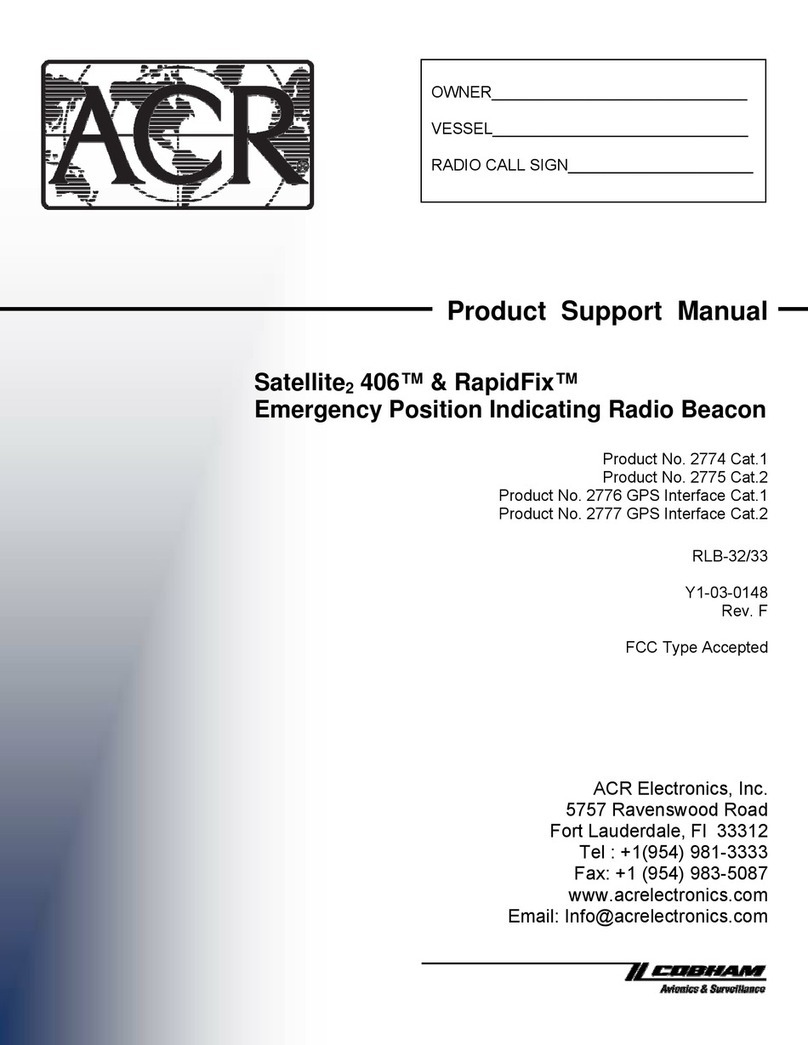
ACR Electronics
ACR Electronics RAPIDIFIX 406 EPIRB Product support manual
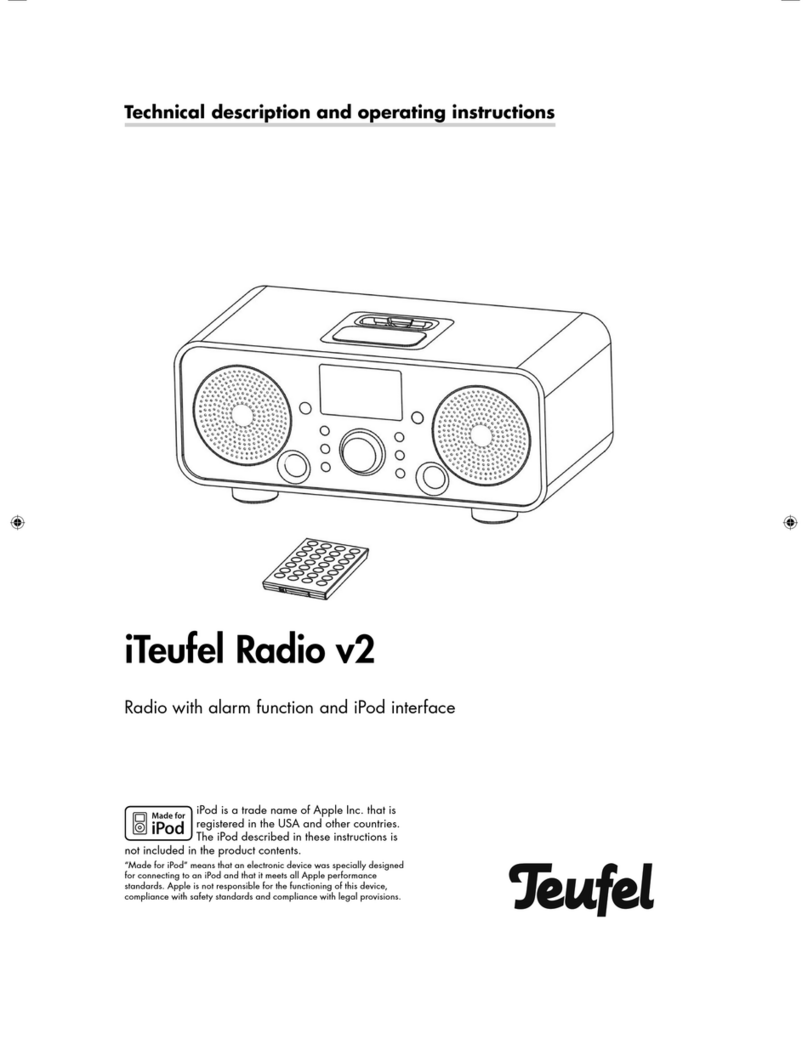
Teufel
Teufel iTeufel Radio v2 Technical description and operating instructions
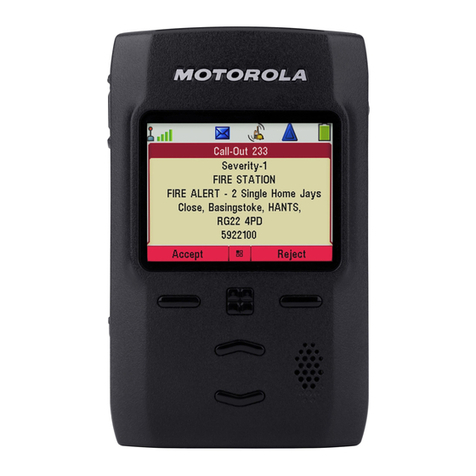
Motorola solutions
Motorola solutions ADVISOR TPG2200 TETRA quick start guide
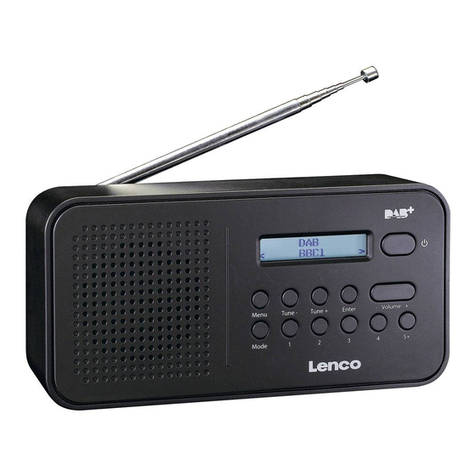
LENCO
LENCO PDR-015 user manual
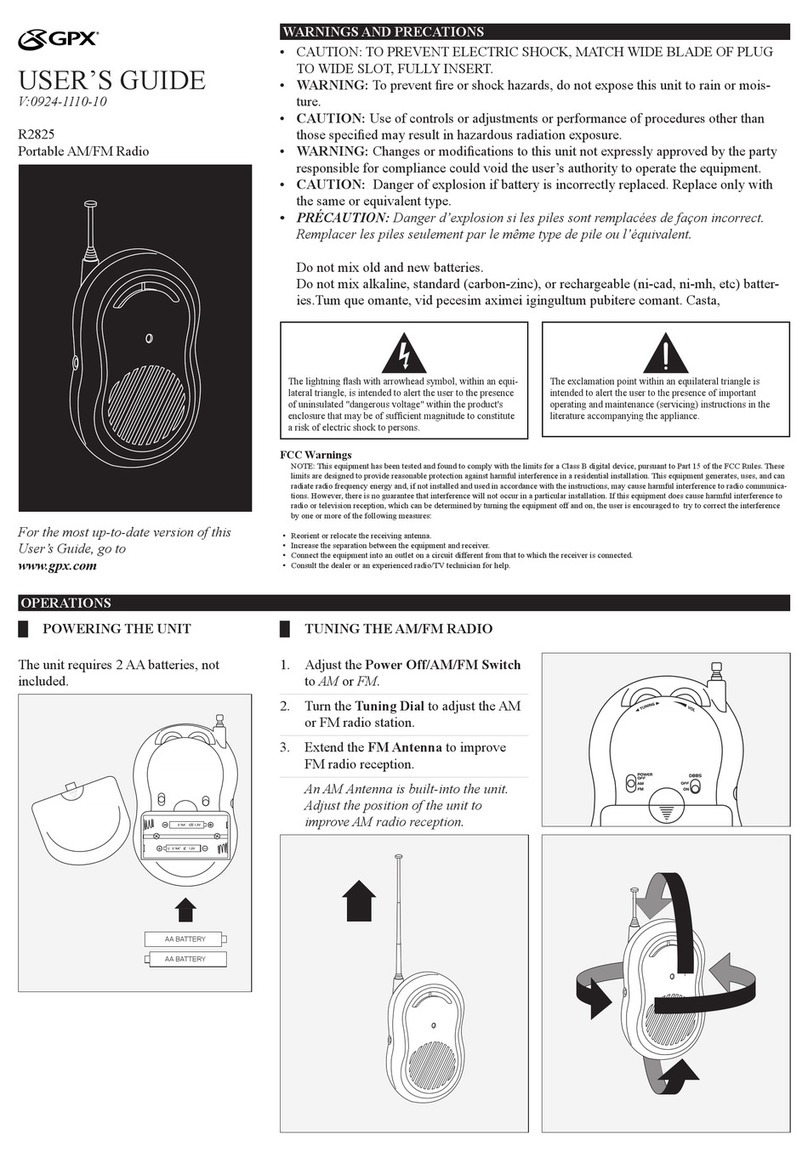
GPX
GPX R2825 user guide

Inrico
Inrico S100 user guide
